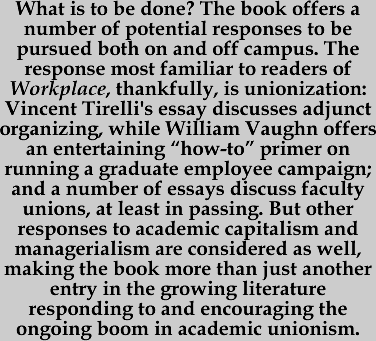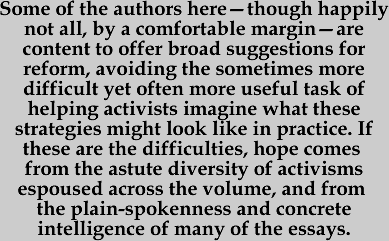![]()
Chalk Lines:
The Politics of Work in the
Managed University
edited by Randy Martin
Duke UP, 1998
Rob Henn
1. Sometimes
academic writing on politics leaves one despairing that academics will
ever become political—become, in other words, effective and collective
activists. Consider the following example. During our campaign
for recognition of the Graduate Employees' Organization (GEO) at the University
of Illinois, Urbana-Champaign, a department head sent a memo to the faculty
and graduate students in his department offering a draft statement of
support for the union. He introduced it thus: "This manifesto [!]
sets two paradigms in relationship, the one essentially political in character and the other
cultural. It recognizes support for the GEO model through signing
petitions, public letters, classroom instruction, etc." Having
efficiently dispensed with the distasteful moment of the political (a
few boring and utterly non-confrontational examples, followed by that
quintessential confession of indifference: "etc."), he went
on much more effusively to describe the cultural paradigm, which he called
relationship, the one essentially political in character and the other
cultural. It recognizes support for the GEO model through signing
petitions, public letters, classroom instruction, etc." Having
efficiently dispensed with the distasteful moment of the political (a
few boring and utterly non-confrontational examples, followed by that
quintessential confession of indifference: "etc."), he went
on much more effusively to describe the cultural paradigm, which he called
-
a co-educator culture of empowerment.
. . . While empowerment culture is contextual, relational and communal
rather than aggregated and majoritarian, the two domains feed off one
another and often intersect and overlap. In an adaptation of Ricoeur,
our multiple symbolic realms committed to justice need not be contradictory,
but enriching while incommensurable.
Before one could guess how this warm and fuzzy empowerment culture was going to stop union-busting lawyers and administrators who didn't seem to possess even one symbolic realm committed to justice, let alone multiple such, the open letter followed with worse surprises. It decried, in what for all the world sounded like boiler-plate anti-union rhetoric, "the adversary language" of "the industrial management model" and called instead for a "participatory public realm of critical consciousness, activism, diversity, and non-violence." (This last item was particularly bizarre, since bespectacled graduate students in thrift-store attire and jowly administrators in suits had never yet come close to trading blows.) As one astute and entertainingly acerbic member of the department soon replied,
The high falutin' rhetoric strikes me as embarrassingly self-important. Since when are we the campus moral leaders who will lead the campus into a brilliantly sunlit non-adversarial utopia? Let the philosophical reflections, qualifications, moral ambiguities and so on wait for the Chattaqua that the open letter evidently envisions.
The politically vague and frankly incompetent statement of support was revised a few times before being published, but not before giving the graduate activists who saw the draft a scare.
2. Chalk Lines: The Politics of Work in the Managed University, I'm happy to report, gives hope for academic activism, both in terms of clarity and specificity. Begun as an issue of Social Text with eight essays on the state of the corporatizing university, the book includes four new pieces. As a whole, it offers a diverse look at both what it calls the "managed" university (more on this term later), and the numerous activist responses to such developments. After an introduction, the book is divided into three sections: "The Whole Business," where essayists offer a discerning bird's-eye view of the recent changes in higher education; "The Academy's Labor," where authors reflect on the nature and purpose of academic work; and "Siting Specifics, Striking Back," where activists detail and offer advice regarding the many forms of resistance created in the managed university's wake. The book thus moves, as should we all, from theory to practice. In so doing, it enlarges our understanding of the new universities we inhabit and sharpens our knowledge of how to change them for the better.
3. Gary Rhoades and Sheila Slaughter provide by far the best big-picture analysis of the "managed university" in the book and indeed in academic culture at large; their lead essay on "Academic Capitalism, Managed Professionals, and Supply-Side Higher Education" provides a brief summary of their crucial, indeed indispensable, work on the global macroeconomics fueling the corporatization of the university. In an era of intensified global competition, they explain, nation-states have steadily drawn money away from such "luxury" items as universities, excepting those very specific and limited parts of the university whose research actually contributes to the nation's "postindustrial" competitiveness. Such overall defunding has pressed administrators to find other types of monetary support, often from private sources, and to engage in corporate-style practices of fostering both internal and external competition—a trend that Slaughter and her colleague Larry Leslie have labeled "academic capitalism." Zelda F. Gamson's essay on "The Stratification of the Academy" notes that academic capitalism has meant that the "research culture" which once seemed to define the university system as a whole has increasingly become the province of a privileged few. Within individual universities, moreover, academic capitalism has had profoundly deleterious academic effects. Faculty are becoming, as Rhoades puts it, "managed professionals," whose academic lives are now subject to attacks on tenure and widening salary gaps. Academic governance itself has become less democratic and more managed, as essays by Christopher Newfield and Jan Currie and Lesley Vidovich note. In place of true faculty participation in the university's governance, we increasingly find a centralized administration calling the most important budgetary shots, and only then—sometimes—offering faculty the privilege of deciding for themselves how exactly to slash their own budgets. And as nearly all the essays note, academic capitalism has put the squeeze on faculty, adjuncts, and graduate employees alike to supply ever cheaper overworked labor. Finally, the effect of such developments on undergraduate students has often been devastating. These students face a sometimes demoralized faculty who are given less and less of the resources they need to devote to teaching (Tirelli); they face ever-rising tuition costs (Meyers, Smith); and they lose access to literacy services now undermined by "welfare to work" programs that care less about true literacy than adult students' short-term employment in dead-end, non-unionized jobs (Hacker and Yankwitt). The "managed" university under academic capitalism has, in other words, resulted in less autonomous and rewarding work for faculty at all levels, and poorer education for undergraduates as a whole—provided they can afford to pay for such mediocrity in the first place.
4. What is to be done? The book offers a number of potential responses to be pursued both on and off campus. The response most familiar to readers of Workplace, thankfully, is unionization: Vincent Tirelli's essay discusses adjunct organizing, while William Vaughn offers an entertaining "how-to" primer on running a graduate employee campaign; and a number of essays discuss faculty unions, at least in passing. But other responses to academic capitalism and managerialism are considered as well, making the book more than just another entry in the growing literature responding to and encouraging the ongoing boom in academic unionism. For example, the most intriguing, and one of the most promising suggestions for internally reforming academic capitalism—though the substance of its practical implementation remains hazy—comes in Rhoades and Slaughter's essay, where the authors (summarizing the conclusions of Slaughter and Leslie's book Academic Capitalism) recommend that universities direct research projects away from private, exclusively profit-oriented corporate research, and toward the aid of public-oriented companies and social services. The book also discusses student movements to retain access to higher education amidst an atmosphere of tuition hikes and attacks on affirmative action, in Bart Meyers's recounting of CUNY's activist history, and more generally in Jeremy Smith's astute essay on "Faculty, Students, and Political Engagement."
5. Chalk Lines also spends significant time discussing ways to make faculty governance more influential, but unfortunately the discussion of this important topic disappoints. Too often, the essays that discuss governance in depth tend to offer overly optimistic governance "solutions" to the larger economic problems other essays admirably highlight. For example, Christopher Newfield's piece on "Recapturing Academic Business" argues for an alliance between faculty senates and unions in order to form a strong faculty bloc that might promote Human Relations Management, as against the Taylorist scientific management we have come to know in the current era of supposed efficiency and top-down control over faculty productivity. What is Human Relations Management? It is a management style that values the contributions of all employees, utilizes a relatively "horizontal" structure of interaction, and promotes a "supportive and anticonformist group life" characterized by innovative team-work rather than back-biting competition (84-85). Newfield's summary of the potential in Human Relations Management is eager, to say the least; such changes might allow us to create "the kinds of transforming collaborations that, in our ongoing Taylorist twilight, we are only beginning to imagine" (100), he concludes breathlessly. And while Human Relations Management arguably provides a useful rhetoric to employ with administrators who might not otherwise be amenable to faculty desires, and while at least in theory it represents an improvement over the "scientific" management model, the potential problems with it are legion, and Newfield doesn't address these in his essay. To cite just two examples, neither the possibility that Human Relations Management, if only rhetorically, might serve more to obscure relations of domination than to alleviate them, nor the awkward fit between Newfield's support of unions with real teeth and his simultaneous hope for a kinder, gentler collaborative management style is discussed. Newfield's enthusiastic support for Human Relations Management also tends to ignore why we sometimes might not want to be empowered employees building the academic firm. When a university gets its funding from, say, oil companies indirectly or directly promoting war, I don't want to be a team player any more. And of course one suspects that any widespread questioning of the university as a whole along these lines might adversely affect Human Relations Management: one can imagine the chancellor or provost telling her resisting employees, in as empowering a manner as possible, to shut up and get back to work.
6. Jan Currie and Leslie Vidovich also discuss problems of governance. They define "managerialism" as a form of governance where an administrative elite sets the broad goals for the institution, which goals are then accomplished by a "line management system" stretching all the way from "the vice chancellor or president through to heads of departments," where each is accountable to a superior. They critique managerial governance for at best perpetuating rather than reducing the inefficiency of earlier forms of governance; for alienating faculty, who are asked to do tasks they don't want to do and for which they are untrained; and for creating an administration-heavy university structure (115). Their pluralist solution entails fostering different modes of governance (managerial, bureaucratic, and collegial) that are used according to the needs of the moment and determined by what they call a "political" model of decision-making involving negotiations and bargaining. This sounds well and good, and like Newfield's Human Relations Management might in practice represent an improvement upon current procedures. But the presentation of Currie and Vidovich's pluralist model offers a simple microcosm of liberal democracy's myth of the level playing field: they hope for decisions achieved "through open dialogue and negotiation among equally situated participants" and an "active trust based on 'open and uncoerced discussion'" (138). But in practice, participants in "political" governance under a class system such as the university simply aren't "equally situated" and discussion simply isn't "open and uncoerced." Employers retain the power to hire and fire employees, not to mention deny tenure or raises, no matter how negotiated faculty governance becomes. Currie and Vidovich's pluralist model, in other words, while perhaps still preferable to straight-ahead managerialism, nonetheless represents a directed form of decentralization where economic goals and power (possessed disproportionately by administrators) still set the trends, and heterogeneous forms of governance tend merely to obscure this arrangement.
7. Chalk
Lines discusses externally-directed responses to the managed university
as well, and here it rightly calls on academics to organize those outside
the academy to support the public sector. Rhoades and Slaughter
emphasize the need for faculty and their unions to define  and
defend professionalism as a form of public service, while Newfield ambitiously
argues further that the university tenure system ought to be expounded
as a model for all workers. Stanley Aronowitz's already oft-cited
essay, "The Last Good Job in America," similarly insists that
academics defend the value of autonomous intellectual labor as against
other, inferior types of work ("most paid labor is shit" [211],
he refreshingly asserts), and that they argue for a system that expands
upon—indeed universalizes—the autonomy preserved in academic labor at
its best.
and
defend professionalism as a form of public service, while Newfield ambitiously
argues further that the university tenure system ought to be expounded
as a model for all workers. Stanley Aronowitz's already oft-cited
essay, "The Last Good Job in America," similarly insists that
academics defend the value of autonomous intellectual labor as against
other, inferior types of work ("most paid labor is shit" [211],
he refreshingly asserts), and that they argue for a system that expands
upon—indeed universalizes—the autonomy preserved in academic labor at
its best.
8. The book as a whole then provides a model of the difficulties and hopes confronting academic activists. The difficulties include a sometimes overly-trustful politics (viz. the book's discussions of governance), and occasionally obtuse language—some of the essays here are less readable than others. Another difficulty, and one shared by academic writing on politics in general, is a curious scholarly evasion of concrete political tactics as opposed to strategy. Some of the authors here—though happily not all, by a comfortable margin—are content to offer broad suggestions for reform, avoiding the sometimes more difficult yet often more useful task of helping activists imagine what these strategies might look like in practice. If these are the difficulties, hope comes from the astute diversity of activisms espoused across the volume, and from the plain-spokenness and concrete intelligence of many of the essays. Along those lines, and in conclusion, the most sage summary and advice comes in Jeremy Smith's essay on "Faculty, Students, and Political Engagement." Smith begins by providing the best aphoristic critique of faculty politics as a whole I've seen thus far: "While some faculty did act as individuals, they never acted as a group and so were never powerful or even influential. At best, they were merely interesting" (251). He then goes on to provide the best precept for faculty—including adjuncts and graduate employees—to live by: "Progressive academics, if they want to be worthy of the name, must express their theoretical work through direct action and political engagement" (256). Finally, and consequently, he also provides superior practical advice: "Integrate political struggle into daily life. Go to demonstrations when they are called; sign petitions; get arrested once in a while; get involved with the community:" (260). Until more higher education workers and students heed such dicta, the corporate or "managed" university—exploiting its employees, demanding its students pay more and more for less and less, restricting both the sum and scope of its intellectual inquiry, and advancing the privatization of education and indeed everyday life itself—will proceed apace. If the readers of this mostly perceptive volume, and of this review, are activists and organizers as well as academics, the book offers hope for a university less managed and corporate, and more democratic.
